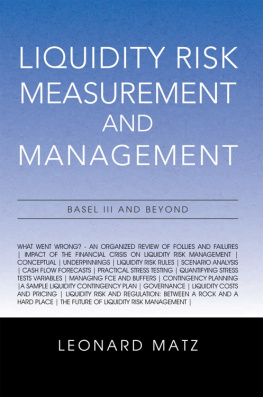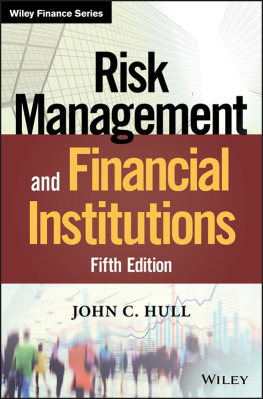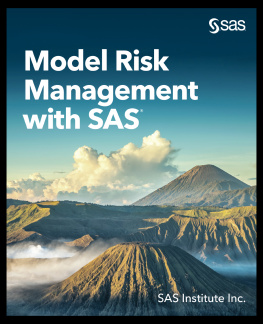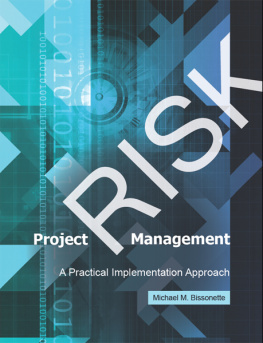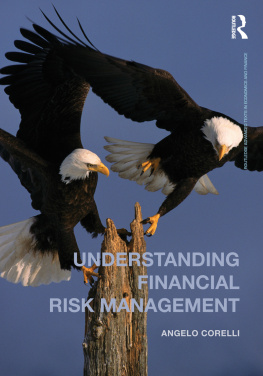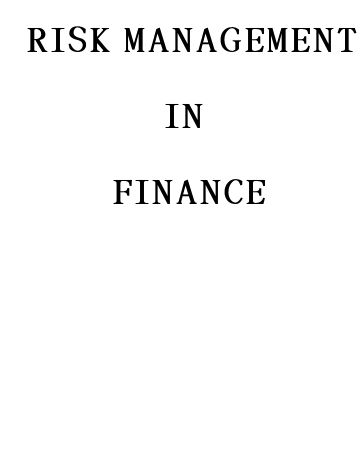

ACKNOWLEDGEMENT
I am grateful to Mr. M.N. Dandekar and Mr. R. Viswanathan, Dy. Managing Directors (Retd.), State Bank of India, Mr. C.Rangamani, Director (Retd.) United India Insurance Co. Ltd., Mr. P.S. Narasimhan, Chartered Accountant, Mr. T.R. Viswanathan, Retired Secretary (Marketing), Life Insurance Corporation of India, Chennai and Mr. P.S.V. Chari, for their valuable suggestions, contributions and Guidance in writing the book. I am thankful to Mrs. S. Santhi for her excellent secretarial work.
I also thank J.S. Institute of Banking and Finance, Bangalore and S.B.I. Learning Centre, Nungambakkam, Chennai for their help in providing reference materials.
PREFACE
Risk management is more of an art than science. Theoretically risk management consists of rules, regulations and procedures. But successful application of the same calls for imagination, innovation and common sense. It is because risk perception differs from person to person and impact vary from one situation to other, standard formula may not work in all cases. The book deals with rules and regulations. Imagination and innovation in application depends on experience and wisdom. However, as a first step in risk management one should learn the risk management techniques based on sound theory (Rules, Regulations and procedures). The book contains good amount of details on rules and regulations and also cover practical aspects of risk management.
Financial crisis is not uncommon. It repeats periodically and cause damage. Many countries have therefore taken steps to improve supervision and strengthen regulatory mechanism. Basel committee on banking supervision (BLBS) and International Association of Insurance Supervisors (IAIS) provide broad guidelines to bank and insurance supervisors/regulators. However situation has not improved. What is the cause for chaos? Simple and straightforward answer is poor risk management. Commercial banks, insurance companies, and investment banks are familiar with risk management processes and in the recent times risk management is given greater importance and has become more sophisticated. However the crisis could not be prevented.
Financial experts are well aware of the intricacies and nuances of risk management and have full faith on the efficacy of the process. But the financial executives who are in the thick of operations either do not generally have perfect knowledge or unwavering faith on risk management process, although they believe it to be useful and necessary. When they handle highly complex transactions involving large amounts their focus is more on profit than on risk. The reason is not ignorance but complacency. They rely more on computer generated mathematical models than their common sense and experience. They are often eager to justify the risk than manage it.
It is in this context I consider it important that the youngsters who have taken career in finance to know more about risk management, have clarity on the basics and imbibe the concept of risk management and its efficacy. University students who have taken finance as their major need to be familiar with the concept. It is my humble contribution to this end by way of a book on Risk Management. It is focused on the freshers and youngsters who enter financial sector as career option. The subject is presented with as much lucidity and clarity as possible. Jargons and mathematical formula have been largely avoided for facile reading. The book is only a primer meant to tell the basics in an unambiguous way. It is absolutely necessary to read more on the subject and also have hands on experience in order to acquire expertise. It is not that the book is not for senior professionals and top executives for whom it will serve as a handy ready reference.
S. Arunajatesan
CONTENTS
S.No. | Description | PageNo. |
| Introduction to Risk Management | 1 - 13 |
| Financial Risk Management | 14 - 26 |
| Enterprise Risk Management | 27 - 35 |
| Overview of Financial and Banking Risks | 36 - 59 |
| Risk Management in Banks | 60 - 76 |
| Insurance Business Risk | 77 - 91 |
| Investment Risk Management in Insurance Companies | 92 - 104 |
| Stress Test in Insurance Management | 105 - 108 |
| Risk management in Investment Banking | 109 - 123 |
| Why Risk Management Fails? | 24 - 134 |
| Conclusion | 35 - 139 |
| Glossary | 140 - 147 |
| Bibliography | |
CHAPTER 1
INTRODUCTION TO RISK MANAGEMENT
The concept of risk management is neither concise nor precise. It is amorphous and untidy, wrapped in uncertainty and buried in confusion.
INTRODUCTION
Everyone considers risk as unpleasant and undesirable. The Oxford Dictionary defines risk as Chance or possibility of danger, loss, injury or other adverse consequence. But its meaning is different for an economist and for whom the risk means actual outcome of an action being different from the expected outcome and it can be either adverse or advantageous. He always links risk with return. It is a trade off between risk and return. It is generally understood that higher the risk, higher the return and lower the risk lower the return. Low risk activities or financial instruments may be safe, but generate low income. In this book we deal mainly with risk resulting in loss of money, property, reputation etc., and the ways and means to reduce its adverse effects.
People for various reasons differ in their attitude and approach towards risk. The propensity to take risk, otherwise known as risk appetite, may be high for some, average or low for some others. One important issue is whether the society or the government can leave the matter to the individual to take risk and expose oneself to the risks. The answer is yes and no. The government of most countries have made laws and regulations on standard accounting practices, transparency, disclosure and also imposed legal requirements or restrictions but did not curb individuals freedom to take risk.
OPPORTUNITIES AND RISK
Life is full of opportunities, but also fraught with full of risks. One cannot take advantage of opportunities without facing certain risks. That is the fundamental truth and reality. In fact, people manoeuvre through life in the world of manifold risks. Under the pressures of modern life style, a risk free environment seems to be impossible. The work place, particularly the factory is beset with various risk factors. Even the well protected homes are not free of risks. There is a need to continuously evaluate such risk exposures to individuals as well as to industrial and commercial enterprises, likelihood or probability of adverse consequences to life, money, assets and manage them to avoid or minimize the effects.
RISK PROPENSITY
There are wide variations in peoples response to risk. There are some who are adventurous and wantonly assume risk and take high risk activities and occupations. On the other hand, there are some others who rarely venture out of their comfort zone. There are also persons who are afraid, but willing to take risk and go along, if there are enough safeguards.
Next page



